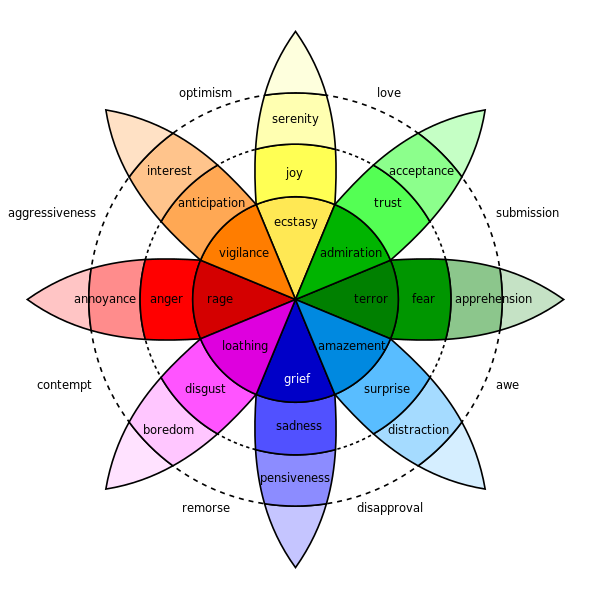 |
| Image from Wikimedia commons |
The image above is Robert Plutchick's Wheel of Emotion. And what does it have to do with writing? Well, I have trouble writing character emotion, and I want to work on that. One of my fellow Critters suggested I make an emotion diagram for a character. I did some googling, and this is what came up.
The idea of Plutchik's wheel is to provide a visual representation of emotion. The outer petals are the weaker degrees of emotion, and the strongest versions go in the centre. Opposite emotions are facing each other, and the theory is that you can't feel these at the same time. Then you have more complex concepts like "awe" between the emotions you need to get to that state. I'm a visual person, so this is very helpful to me.
I can see using this model to track character emotion, and especially the degree of emotion, and to check that the character is going through these stages, like boredom-> disgust-> loathing.What if you want the character to end up in the opposite of this? Acceptance-> trust-> admiration. What about from fear to anger? I could see that being interesting as a character arc.
And what if you want to show contempt? Do you need to show disgust and anger to get there?
You can see the primary dyads (mixtures or two base emotions) here, but Plutchik also came up wit secondary dyads (joy+fear->guilt, for example), and tertiary dyads (joy+surprise->delight). Here's a handy poster with a collection of all of these, and polar opposites, too. It includes a chart of how emotion guides us in facing certain events, and you can see how emotion was probably an evolutionary advantage.
Not your thing? Maybe you'll find these helpful: The Emotion Thesaurus: A Writer's Guide to Character Expression by Angela Ackerman and Becca Puglisi. They have also written a positive and negative trait thesaurus, which are good for ideas. These are, as the title says, thesauruses. You have an emotion, a definition, physical signals, internal sensations, mental responses, cues of acute or long term emotion, cues of suppressed emotion, and a writer's tip at the end. The positive and negative trait thesauruses have a trait and exploration of how the character came to have it, and also traits that conflict with it, so you can think about having another character that doesn't get along with the first one. So if you need help with building flawed characters, these might help.
I'm also exploring deep point of view, but more on that later.
Happy writing!
Thanks for great information you write it very clean. I am very lucky to get this tips from you.
ReplyDeletehttps://blog.mindvalley.com/types-of-emotions/
Positive site, where did u come up with the information on this posting? I'm pleased I discovered it though, ill be checking back soon to find out what additional posts you include. this
ReplyDeleteI just found this blog and have high hopes for it to continue. Keep up the great work, its hard to find good ones. I have added to my favorites. Thank You. view
ReplyDelete